
Hallowe’en was observed by the Irish settlers in Lanark County, in the earliest times, after their arrival. At that time, it was not a holiday centered around children collecting candy, but instead, marked a spiritual night when the veil between the living and the dead was at its thinnest, allowing spirits, good and evil, to pass through.
The celebration of All Hallows Eve, or Hallowe’en originated in Ireland, with the ancient Celtic festival of Samhain, (pronounced sow-win), (sow sounds like cow). The Druids, the high-ranking members of the Celts, built enormous bonfires, and everyone in the community, young and old, gathered around. The Celts wore simple costumes, consisting of animal skins, to hide themselves from evil spirits, and believed that on that special night, they had the ability to tell each other’s fortunes.

Samhain marked the end of the harvest, and the beginning of the dark, cold winter. The Celts believed that on October 31st, the boundary between the worlds of the living and the dead became blurred, and that the ghosts of the dead returned to earth.
When the evening’s celebrations around the fire were over, each family brought a small torch from the bonfire, and used it to re-light their hearth fires at home, believing that it would protect them during the coming winter.
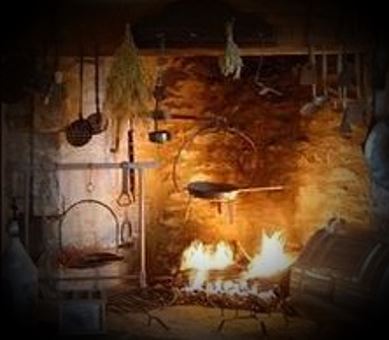
Lanark County Irish Hallowe’en
There were many ancient customs, traditions and even food, associated with the early Irish settlers to Lanark County, each year, on October 31st. Although many of the pioneers were Roman Catholic, a handful of customs from the times of the Celts still remained. Some of the traditions were centered around the idea that everyday people were able to predict fortunes on this special night. A traditional Irish fruit loaf was baked, which held specific symbols that were believed to predict each person’s fate. (recipe below)
A large part of the evening was the telling of ghost stories. Some of the early settlers were not able to read nor write, so the story-telling was a way to pass down their traditions and beliefs, so that the next generation would remember them.
On Hallowe’en, after dusk, when the last light had faded from the sky, it was customary to light a few candles, push back most of the furniture against the walls, and sit around the hearth. The lady of the house would serve the fruit loaf, with butter, jam, and tea, shots of whiskey for the grown-ups, and the telling of the ghost stories would begin…..

This is a story that was told in the 1930s in Perth, by Jimmy McNamee, our father’s cousin, about the night his parents Mary Quinn, and Maurice McNamee, heard a Banshee, while they were walking down a dirt road, coming from a house party.
Legends say that the cry of the Banshee foretells of a death, and the old timers claimed that only those with pure Irish blood running through their veins, could hear the cry of the Banshee.
Some of the Irish settlers said that the Banshees were withered, scowling old women, but many said the Banshees were pale, fair-skinned beauties with red flowing hair, who could bewitch men with their charm. It was said that each family had its own Banshee, and that they followed the people who left Ireland, across the ocean, to their homes in the new world.
Not long after they were married, in the late 1860s, Maurice, and his wife Mary, were coming home after a dance at a neighbour’s house. They were walking down a bush road, not far from Stanleyville, when they heard a cry unlike anything human they had ever heard. It was half sobbing, half moaning cry, as though someone was in distress.
Mary Quinn McNamee said, “Maurice, can that be a Banshee?”
Still fairly close to the neighbour’s house, they decided to turn around and go back, and tell the others what they’d heard. During the short walk back to the house they heard the cry a second time, and just before they reached the front door of the house, they heard it again.
After reaching the house, they told the neighbour and the rest of the guests what they’d heard, and everyone came outside to listen, but the cries were not repeated.
Three days later a man died accidentally in the bush close to the house where the dance was held……

Many stories were passed down over the years about Jimmy Whelan’s tragic drowning, and his beautiful young lover, who still walks at night, along the shores of the Mississippi River, searching for her beloved Jimmy. This story was told and re-told in the area of Ferguson Falls, particularly at the infamous Stumble Inn, operated by Billy McCaffrey.
The Phelan family (this family pronounced their name as Whelan), had a farm along the 11th concession of Drummond Township, backing onto the Stafford farm. The two farms were separated by the Mississippi river. My great-grandfather, Thomas Stafford, was a friend of Daniel Phelan, younger brother of Jimmy, so he knew the family well. It was well-known in the area that of all the children in the family, Jimmy, was his father’s favourite, and in the father’s will, Old Man Phelan even singled him out, referring to him as “his beloved Jimmy”.
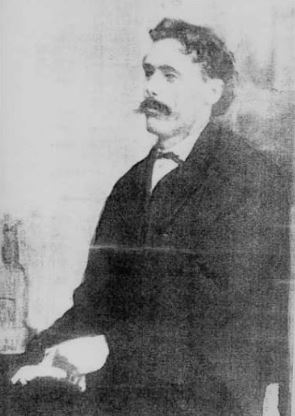
James ‘Jimmy’ Phelan, of Drummond Township
It was said that Jimmy possessed a spirit of wanderlust, and instead of working on the family farm, he was drawn to the excitement of living in a lumber camp, moving from place to place, along the river. All winter long they cut and hauled tall white pine logs, to the Ottawa River’s nearest tributary, and in the spring, when the ice broke up, they floated the logs down the river. One year, the water on the Upper Mississippi was particularly high, and a dangerous jam formed. The jam shifted, and Jimmy and the foreman, both standing on floating logs, were knocked into the cold icy waters. The foreman was rescued, but they didn’t recover Jimmy’s body for over half an hour. It was a terrible tragedy.
In the old days, the Irishmen would sit outside of Charlie Hollinger’s hotel, in Ferguson’s Falls, and one of the stories they told was about the ‘gates of glass’. They believed that at dusk, between the rising and the setting of the moon, when the waters were still, the veil between the world and the spirit world becomes very thin. It was said that spirits could pass from one realm to another through the still waters, and this was known as the ‘gates of glass’.
Many years later, following the death of Jimmy’s former lover, people in Ferguson’s Falls began to see what appeared to be a misty image of a young woman, walking along the shores of the Mississippi. The old timers said it was the spirit of Jimmy’s beloved, trying to reunite with him.

They say she still walks along the river at dusk, searching for Jimmy.

Although there were three hotels at one time in Ferguson’s Falls, perhaps none had such a wild reputation as the Stumble Inn. The hotels in the village were popular with the locals, travelers, and the lumber crews who worked along the river. The difference between the larger hotels and the much smaller Stumble Inn was that the smaller bar chose to ignore the local laws for their operating hours, and so, alcohol could be purchased at almost any time, including Sundays. There was even a Sunday ritual among some of the male parishioners of the nearby St. Patrick’s Roman Catholic church – to stop by, before, or after services, for a wee nip of whiskey.
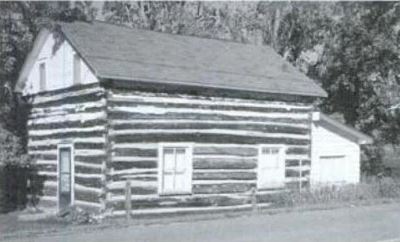
The Stumble Inn, Ferguson Falls
The longer business hours of the Stumble Inn might have been the reason for the legendary fighting that took place at this small establishment. More drinking, naturally led to more fighting. Apart from the fighting though, it was also a place where a young musician, like Dad’s uncle, Jimmy Richards, could bring their fiddle or flute, and were encouraged to entertain the patrons; and so, it also became known as a venue where the budding musicians of the area gained experience performing for the crowds. Along with the music, and the fighting, there was card-playing, gambling, and story-telling.
Billy McCaffrey, owner of the Stumble Inn, passed away in 1940, and most of the old musicians who played there are long gone. Some say that if you walk along the river near the Stumble Inn, on a warm summer’s eve, you can still hear the echoes of the music and the laughter – the spirits of the old gang who frequented the Stumble Inn.
(William Henry ‘Billy’ McCaffrey, owner of the Stumble Inn, was a cousin to the Staffords, through his grandfather, Peter McGarry, brother of our great-grandmother, Betsy McGarry Stafford.)

Michael McNamee and his family sailed from Warrenpoint, Ireland, on the ship, ‘Dolphin’. According to stories passed down by Michael, the voyage took seven weeks, and he sailed in the company of Michael Stanley of Stanleyville, and Michael Cunningham, who settled in Perth.
It was a common belief at that time, when the Irish immigrants arrived in Canada, that their particular banshees, family fairies, and little people, came with them.
Michael’s son, Maurice McNamee, and his helper, George Murphy, worked as charcoal burners on the west side of the hills, close to Westport. They lit the wood, and covered it with a bed of sand so that the wood might be merely charred instead of being burned. They sold the charcoal to local families, and it was used for cooking, to heal wounds, to ingest in the case of food poisoning, and to mix with ash to make cleaning products.
One morning, Maurice and George returned to their work site, and found the sand they poured over the charcoal pit was covered with tiny foot-prints. The prints were about two inches long, and were in the same shape as a human foot. Both the marks of the heels and the ends of the toes were very clear, and the entire surface of the pit was covered with the footprints, as though some tiny folk had been dancing on the mound.
Maurice and George did not want to disturb the sand. They wanted someone to come and see the prints to verify what they had found. There was no camera in those days, and they had neither pen nor paper with them to draw a sketch of what they’d seen……
Maurice told the story often, and then his son, Jimmy McNamee, passed the story down to the locals in the Perth area. Jimmy was a bit of a legend in the area for his story-telling skills, and often came to one of the hotels in Perth, and passed the old stories down to all who were interested. Our Dad heard that particular story from Jimmy in 1935, in Perth, and passed it down to us.
(According to Jimmy, ghost stories were not told at daytime activities like barn-raisings or at gatherings in broad daylight. It was in the evening, gathered around the hearth, or a bonfire, that the stories were to be told by the old-timers, and passed down to the younger folk, from one generation to the next. Jimmy’s son, Sylvester, was married to Dad’s cousin, Bridget ‘Carmel’ Stafford)

Predicting Your Future Husband with an Apple Peel:
All of the young ladies present at the gathering carve a long single peel from an apple, and toss it over their shoulders. It is believed that the peel will fall on the floor in the shape of their future husband’s initials!

Fortunes Told with Saucers
Another custom involved the placing of three saucers on the table. Salt is poured onto one saucer, the second saucer holds a ring, and the third saucer holds a small mound of earth. Each person is blindfolded, and led around the table three times, and then places their right hand on one of the saucers. If they touch the saucer containing the earth it is a reminder that the time is not far off when they will be but a handful of graveyard soil; if they touch the saucer with the ring it means that a happy marriage will be theirs; and if they touch the salt they will cry tears in the next year.
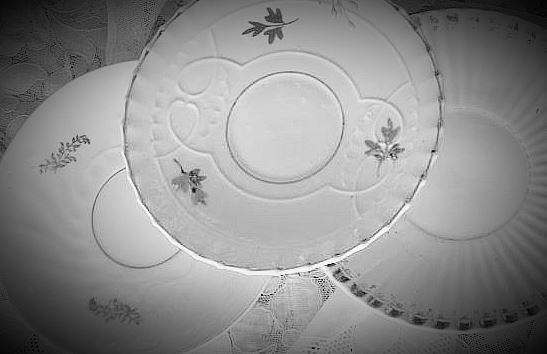
Leaving a Path for the Fairies
Many believed that on Hallowe’en the fairies like to come in, and warm themselves at the fire. It is customary to move the furniture back toward the walls, and leave a clear path from the front door to the fireplace so the fairies will come in, sing and dance with the family, and tell them what the future holds.

Many bake a special cake for Hallowe’en called a Barmbrack. Inside the cake the baker places a match, a tiny piece of cloth, a ring, a thimble, and a button. The cake is cut into pieces, and given to those present at the gathering. The person who finds the match will have conflict in their life, whoever finds the piece of cloth will suffer from poverty, the person finding the ring will be the next to marry, the one who finds the thimble will not marry, and if a man finds the button he will be a bachelor forever.
Traditional Irish Barmbrack for Hallowe’en
Ingredients
2 ½ cups chopped dried mixed fruit
(raisins, apples, currants, cherries)
1 ½ cups hot brewed black tea
2 ½ cups all purpose flour
1 tsp cinnamon
½ tsp nutmeg
½ tsp baking soda
1 egg
1 ½ cups sugar
¼ cup marmalade
1 tsp finely grated orange peel
Soak the dried fruit in the hot tea for 2 hours, then drain and gently squeeze out excess tea.
Stir the flour cinnamon, nutmeg, and baking soda together in a bowl
Beat the egg, and combine with the sugar, marmalade, orange zest, and tea-soaked fruit
Fold in the flour gently and pour into the pan.
Bake in a greased 9-inch Bundt pan at 350, for 1 hour, or until the top of the cake springs back. Allow to cool in the pan for 2 hours before removing.
Wrap the objects in waxed paper (thimble, ring, etc.) and press into the cake through the bottom before serving.
The loaf may be served with tea in the afternoon, after dark on Hallowe’en, or may be sliced, toasted and served with butter and jam for breakfast
And so, the spooky traditions of Hallowe’en were passed down through the generations, from the earliest Irish settlers in Lanark County, and on down through the years, from the old timers, to the young ones.
The ghost stories were told, and re-told, at night outside, around the Hallowe’en bonfire, or in the home around the hearth. Shots of whiskey were often served, or for the younger folks a cup of strong black tea, along with a slice of the traditional buttered fruit loaf.
As the evening progressed, and the whiskey took hold, there was always music, fiddling, flute-playing, singing of the old traditional songs, the telling of jokes, and many exaggerated tales of glory from days gone by.
Whether you spend your Hallowe’en in the traditional ways of our Lanark County Irish ancestors, or you have your own customs that you practice on this special night of the year, have a very happy and safe Hallowe’en, and be sure to watch out for the ghosts, and the little people!
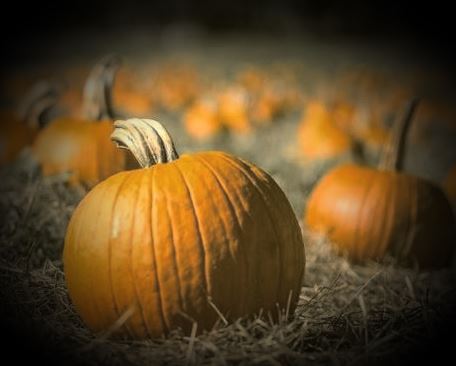
For more Lanark County Irish Ghost Stories:
The story of Jimmy Phelan and the Ghost of Ferguson Falls, in its entirety, in “Lanark County Calling: All Roads Lead Home”.
For the tale of the Banshees in North Burgess Township, and the Little People of Westport – “Lanark County Classics: A Treasury of Tales from Another Time”
For more information on The Stumble Inn of Ferguson Falls – “Lanark County Collection: Winding Our Way Down Memory Lane”

Honorary Life Member – Lanark County Genealogical Society
Member, Association of Professional Genealogists
Author of: “Lanark County Christmas”, “Lanark County Comfort”, “Lanark County Collection”, “Lanark County Calling”, “Lanark County Classics”, “Lanark County Connections”, “Lanark County Calendar”, “Lanark County Chronicle”, “Lanark County Kid”, & “Recipes & Recollections”
new for 2023: “Lanark County Kitchen: A Maple Legacy from Tree to Table”





